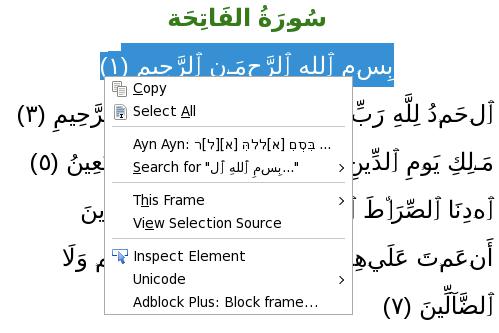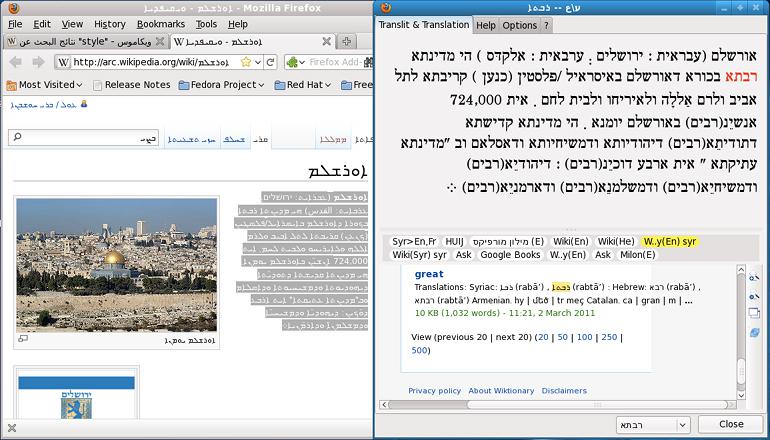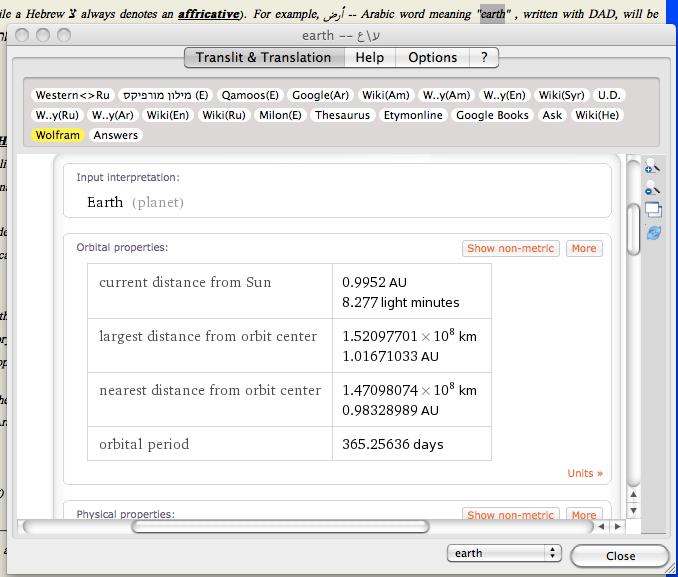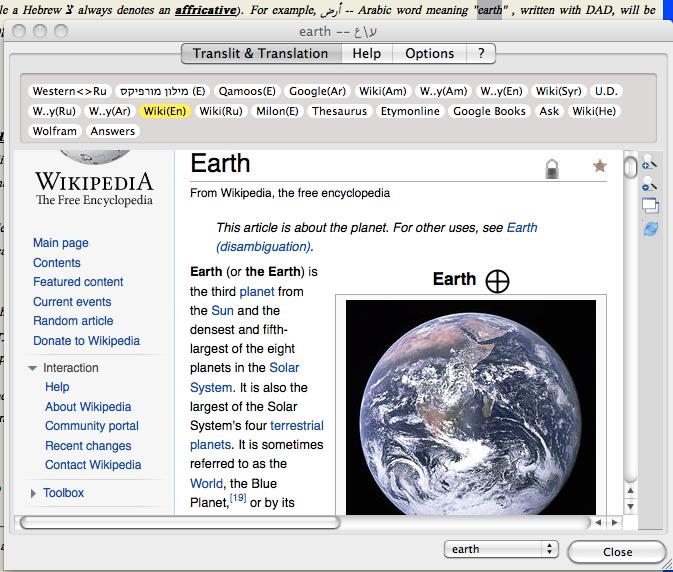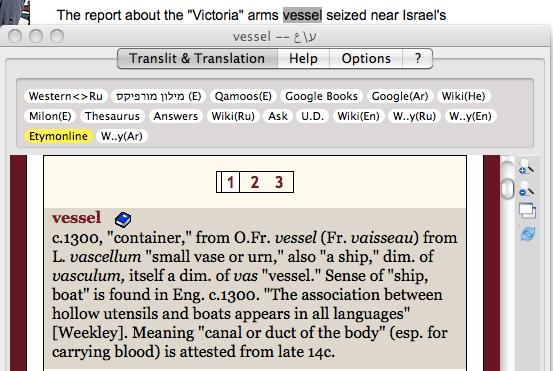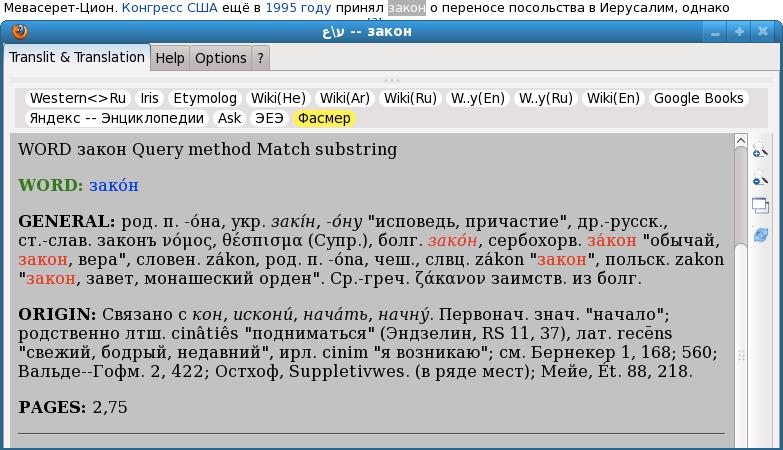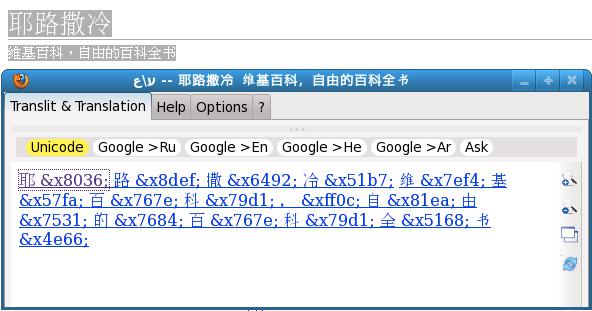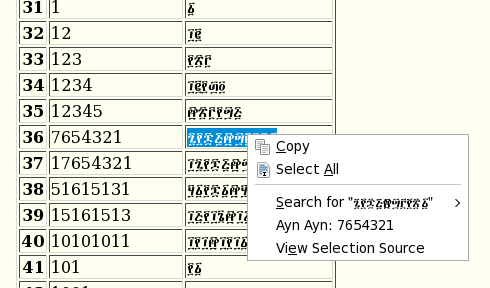ע\ع (Ayn\Ayn) Lookup
[former ע\ع (Ayn\Ayn) Converter]
is a multi-purpose text research
Mozilla XUL web-browser
add-on
with
advanced support of Semitic languages. It looks simultaneously for a selected text
in many online dictionaries, encyclopedias and in other online resources.
Also it converts texts written in Arabic/ Syriac/ Phonenician/ Imperial Aramaic
scripts (with diacritics if any) to
Hebrew writing system
(and can feed Hebrew text, transliterated to Syriac writing system,
to a Syriac dictionary to find Aramaic translations there)
.
Also, it's possible to use this converter
online in any browser
to convert any text to Hebrew writing system.
The add-on had been developed as a Mozilla XUL browser add-on, it is not compatible with new Firefox Quantum (the web-version is compatible with Quantum, of cause), but it works with SeaMonkey, Basilisk, Pale Moon, Waterfox and other browsers based on Mozilla XUL.
Full list of the features:
- Transliteration of Arabic/Syriac text, vocalized or not, to Hebrew writing system
(read more).
- Translation of the text with various online dictionaries and translation services.
Some stemming can be performed by the Add-On if a word is not found in a dictionary.
There is support for
Ar>En, He, Ru ; He>Ar, En, Ru ; West European Languages>Ru ; Syr>En, Fr ; Aram>He ; Persian>En ;
Yiddish>En ; Ru>West European Languages , Ar, En
dictionaries. Google Translate is used to translate text blocks or when a dictionary translation
is not available. Also the Add-On utilizes Wikipedia's "see in another language" links to translate available terms.
- Articles from various encyclopedias and other related sources.
-
Etymological information.
- Unicode info on each character of the selected text.
- Ge'ez number converter.
Following online services are supported:
- Dictionaries and translators:
- All languages:
- Arabic:
- Google
Dictionary/Google Translate (to English)
- Google
Translate only (to other languages)
- http://www.ar-ru.ru/slovari (to Russian)
- http://www.syriacstudiesdic.com/
(to Eng,Fr,Syriac)
- https://glosbe.com/ar/he/ (to Hebrew)
- English:
- http://www.syriacstudiesdic.com/
(to Arabic,Fr,Syriac)
- http://morfix.co.il/ (to
Hebrew)
- http://dictionary.statme.ru/
(to Russian)
- Google
Dictionary/Google Translate (to supported languages)
- Japanese:
- Google
Dictionary/Google Translate (to supported languages)
- Maltese:
- Google
Dictionary/Google Translate (to supported languages)
- Polish:
- Google
Dictionary/Google Translate (to supported languages)
- Portuguese:
- Google
Dictionary/Google Translate (to supported languages)
- Spanish:
- Google
Dictionary/Google Translate (to supported languages)
-
http://www.diccionario.ru/(to Russian)
- Syriac (Aramaic):
- http://www.premiumwanadoo.com/cuneiform.languages/syriac/
- http://wikimedia.cet.ac.il/mediawiki/
(to Hebrew)
- http://www.syriacstudiesdic.com/
(to Eng,Fr,Arabic)
- Persian:
- Google
Translate
- http://dsal.uchicago.edu/dictionaries/hayyim/
- http://dsal.uchicago.edu/dictionaries/steingass/
- Hebrew:
- http://www.slovar.co.il/ (to
Russian)
- http://morfix.co.il/ (to
English)
- http://www.2letterlookup.com/
(Hebrew/Aramaic to English)
- http://www.sdbh.org/vocabula/(to
English)
- https://glosbe.com/he/ar/(to Arabic)
- Russian:
- To/from western languages (English, German, French,
Italian, Latin, Spanish):
https://lingvolive.ru/
- http://www.slovar.co.il/ to
Hebrew
-
http://www.diccionario.ru/ (to Spanish)
- Turkish:
- Google
Dictionary/Google Translate (to English)
- Google
Translate only (to other languages)
- Western languages (English, German, French, Italian, Latin,
Spanish) to/from Russian:
https://lingvolive.ru
- Yiddish:
http://yiddishdictionaryonline.com/
- Phoenician:
http://canaanite.org/dictionary/
- Other searches:
- General purpose:
- http://www.answers.com/
- http://ask.com/
- http://www.google.com/
- http://wikisource.org/
- http://wikiquote.org/
- http://www.wolframalpha.com/
- Language:
-
Этимологический словарь Фасмера
- http://www.etymonline.com/
- http://etymolog.ruslang.ru/
- http://www.urbandictionary.com/
- http://freethesaurus.net/
- Biology:
- Encyclopedia
of Life
- http://species.wikimedia.org
- Hebrew/Israeli/Jewish:
- http://www.mima.co.il/ (פירושים
לשירים ישראלים)
- http://www.daat.ac.il/ דעת --
אנצקלופדיה יהודית
- Электронная
еврейская энциклопедия
- קיצורים
וראשי תיבות בעברית
- Lyrics:
- Social networks:
- Funny stuff:
- Encyclopedias:
- http://www.britannica.com/
- Wikipedia
-
Кругосвет
Current version of the extension is 1.15.2.
The changelog.
Disclaimer
This program is distributed in the hope that it will be useful, but WITHOUT ANY WARRANTY;
without even the implied warranty of MERCHANTABILITY or FITNESS FOR A PARTICULAR PURPOSE.
The Author shall not be responsible for, and shall not pay, any amount of incidental, consequential or other
indirect damages, whether based on lost revenue or otherwise, regardless of whether
The Author was advised of the possibility of such losses in advance.
Install the extension from the Mozilla site.
In order to use this software, select a text block (a word or several words, or a word part) with a mouse in
the browser window then
use context menu to get the transliteration, the translation, and the other selection related info.
Principles of the Transliteration
Aramaic and Arabic languages are close relatives of Hebrew, and transliteration to
Hebrew writing system makes many words recognizable for a Hebrew speaker.
The transliteration model is made to make the Arabic
words easy recognizable for a Hebrew reader
(the pronunciation is given according to the literary Arabic
pronunciation)
.
In the Hebrew, letters בגדכפת
have (or had) two variants of pronunciation : plosive and
fricative.
Dagesh Qal is used to denote a plosive variant.
Lesser known upperscore line -- Rafe, may be used to denote a fricative one.
The converter uses both these signs. Also, it uses
geresh
sign to mark a letter with a
different from the Hebrew pronunciation if both the letter pronunciation variants are
plosive or fricative (the converter, where it is possible, does not use the
modern Hebrew
geresh based Arabic transliteration).
While in the modern Israeli Hebrew only כ and פ still have each two pronunciations, in the
Liturgical Mizrahi Hebrew all בכפת letters
have two pronunciations (גד have each two pronunciations in the Yemeni Hebrew ),
and this converter uses Liturgical Mizrahi/Yemeni Hebrew בגדכפת pronunciation
to reflect specific Arabic sounds in the transliterated text.
In Arabic, פ/ف always sounds as F, ב/ب is always B, and כ/ك always denotes K, but د ط ح ص ت (equivalents of דטחצת), like Hebrew בגדכפת, denote each two sounds
where a variant with a pronunciation different from a basic Hebrew/Aramaic pronunciation, ordinarily a fricative one, is marked with an additional dot
(that mostly acts like a raffe).
While ح denotes the same sound as Mizrahi Hebrew ח ,
خ
denotes the same sound
as כֿ , and it were phonetically consistent to map خ as כֿ (and early versions of the converter used this mapping).
But the problem is that خ is linked etymologically not with כֿ but with ח (it is thought that there were two sounds in
Proto-Semitic,
and still exist in Arabic, those joined in one Hebrew sound/letter), and recent version of the
converter maps خ to ח׳. Contrary, it is thought that one Arabic/Proto-Semitic sound ك corresponds with two distinct Hebrew sounds.
With the Dagesh (and w/o Rafe) דכת ,in transliterated text, denote the same sounds as in modern Israeli Hebrew (ט
denotes an Arabic/Mizrahi Hebrew
[tˤ]
), but צּ denotes a specific
consonant ض DAD
that is the plosive variation of the tsade, but sounds closer to D (while a Hebrew צ always denotes an affricative). For example, أرض
-- Arabic word meaning "earth" , written with DAD, will be transliterated as ארץּ and, therefore, is easy recognizable.
With the Rafe (and w/o Dagesh) דטת letters, according to the description, denote:
| דֿֿ/ذ | sound like "th" of the English word "this" |
| טֿ/ظ | sound like "th" of the English word "thus" |
| תֿ/ﺙ | sounds like "th" of the English word "thin" |
The letter غ GHAYN
denotes an ר-like sound, voiced uvular fricative.
Many ashkenazi Jews pronounce ר by this way. It were phonetically consistent to transliterate it as רֿ, but the converter maps it to עֿ, because
غ
is linked etymologically with ע and not with ר.
In the converted Syriac text GHAYN ordinarily will be mapped to גֿ , for example, in the word בגֿדד
( a special dot "רוככא" is used in the original text to mark a "soft" letter )
.
The letter ر\ר denotes itself, in Arabic, a trill sound close to the Amharic/Russian R. This sound is very difficult for most ashkenazi jews
to pronounce, and local helpers of nazis in the Eastern Europe used a russian word "KUKURUZA"/"кукуруза" as a shibboleth to recognize jews for the extermination.
The letter and the diacritic sign ء HAMZA denotes a glottal stop
while alif w/o HAMZA denotes mostly a long /a:/ vowel.
In the Hebrew, א denotes a mandatory glottal stop when the alef has a shva niqqud אְ, or when the letter just before the alef has a shva .
The converter treats HAMZA as a mandatory stop, and puts alef with shva there, but omits the leading אְ. For example إِسْرَائِيل will be transliterated
as
אִסְרָאְיִיל
.
ى ʾalif maqṣūrah (ألف مقصورة) denotes a shot /a/ at the end of a word,
it looks like a dotless ـي
, the converter
renders
it as
"ַא"
. A problem is that Egyptians ordinary omit the dots in ـي , the converter can not process such ـي properly and renders
ַַא in place of the proper י
The shva in the converted Arabic text should never be pronounced,
as sukun (سكون)
it denotes absence of vowel. Kamatz denotes long /a:/ in the converted Arabic and Eastern Syriac texts, but /o/ in the converted Western Syriac.
|

